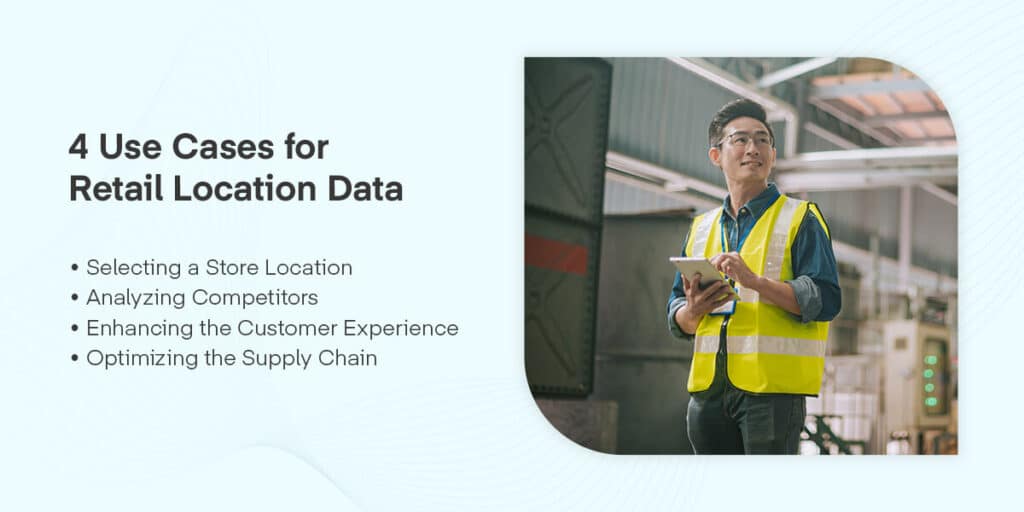
Retail POI Data: Common Applications and Competitive Use Cases
According to real estate experts, location is everything. And this phrase is just as true for retail as it is for the real estate industry.
Data-driven decision-making is essential for making sure you’re positioning your business for success. Whether you’re looking to expand your presence abroad or begin opening new stores domestically, global point of interest (POI) data and analytics are essential tools for making the right geographical decisions for your company.
Let’s explore some of the most common use cases and applications for retail datasets.
What Is Retail POI Data?
Point of interest data is information about a specific physical location. A POI can be any location someone finds interesting, such as a retail store, hospital, restaurant or grocery store.
4 Use Cases for Retail Location Data
Businesses can use data in many creative ways, but here are the top four use cases for retail companies.
1. Selecting a Store Location
When expanding your business or moving your store to a new area, you want to make sure you’re setting up shop in a profitable location. Retail store location data can help you choose the ideal spot.
Site analysis can help you evaluate whether a site is right for your business based on factors like:
- Competition: One of the most important parts of a site selection analysis is making sure you’re not moving into an area that already has a high concentration of competitors in your sector.
- Nearby businesses: POI data can help you understand what businesses outside your sector your target demographic likes to visit and how far they are from your location.
- Residential areas: Having residential neighborhoods near your chosen location could help you attract customers who don’t want to go too far from their homes to shop.
Ultimately, the goal of site analysis is to find a location that has a sizable population of your target customer base with few competitors.
2. Analyzing Competitors
Competitor analysis is vital for getting a leg up over the competition in a specific location. Some important questions POI data can answer include:
- What about your competitors’ physical stores is attracting your customers?
- Are they in a good location with supporting businesses nearby?
- Is their store near a residential or commercial hub?
- Do they advertise well to the customers in the area?
- How many of your other competitors are close by?
The more you know, the easier it will be to determine where you need to stake your new location.
3. Enhancing the Customer Experience
POI data is a great tool for gaining insight into customer preferences and behaviors.
Retail store location data can help you provide a more fulfilling customer experience at existing and new locations by:
- Navigation: Customers should be able to find and travel to your store quickly and easily. POI data can help you choose a convenient, highly visible location within a short distance of your target market, or other businesses they frequent.
- Geotargeted marketing: Accurate, up-to-date location intelligence enables you to take advantage of cutting-edge advertising techniques that appeal specifically to customers in an area.
- Location trends: Where do your customers prefer to spend their time? What hot businesses are in your area? POI data can help you leverage these insights to keep your target market engaged.
- Region-specific offerings: Understanding your customers is essential for effective localization. This information can help you tailor product and service offerings for each country you operate in, appealing to local tastes and meeting customer demand.

4. Optimizing the Supply Chain
Thanks to e-commerce pioneers like Amazon, customers now expect to receive deliveries in just a few days.
POI data can also help you leverage your geographical location to shorten lead times and improve order fulfillment for customers living nearby. If you’re trying to decide where to put a distribution center, warehouse or other logistical facility, a thorough site analysis using retail POI data can help.
For example, an e-commerce company could use retail POI data to find an ideal lot for a warehouse that’s close enough to the business’s target market to meet customers’ increasingly high expectations.
Additionally, POI data that updates in real time can enable your company to provide customers with live order tracking. Customers can rest assured knowing valuable purchases are safe and on the way, which is one of the best ways to improve the delivery experience.
Finding Good Retail Datasets: Tips and Tricks
When buying POI data, you must ensure that the dataset is accurate and well-maintained. Here are some tips you can use to find the best data for your intended application:
- Check for data quality: Request a free sample from your data provider to make sure the dataset is complete, current and accurate. If you have any questions, reach out to the provider’s customer service department for more information.
- Make sure it offers wide coverage: Whether you’re looking to expand internationally or gather intelligence on your nearby competitors, you’ll need to ensure the datasets you use cover the areas you need.
- Ask about licensing terms: Your data needs will vary depending on your intended use case, so it’s important to make sure you’re only paying for the data you use. A provider that offers flexible licensing plans can help you ensure your investment aligns with your goals.
- Choose a trustworthy provider: While open-source data sets are more cost-effective, they’re often riddled with errors and outdated data points. Instead, look for a paid data provider that updates their data in real time to ensure you always have access to the most recent information.
If you’re looking for a dynamic, cost-effective and accurate source of high-quality POI data for retail stores, dataplor is the data provider for you.
Get Quality POI Data for Retail Stores From dataplor
The right data makes an enormous difference in the success of your business. Working with a reliable POI data provider is the only way to get the data you need without worrying about inaccuracies.
At dataplor, we combine powerful AI capabilities with an international team of human validators to ensure your retail location data is always accurate and up to date. Our data covers more than 200 countries and territories worldwide, so you can gain insight into points of interest virtually anywhere on Earth.
Contact us today to speak with one of our experts or request a free data sample to see how dataplor can help you reach your business goals.

